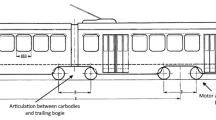Abstract
In this study, we optimally design the core of a metal sandwich panel used in high-speed railway vehicles to minimize the amount of metal solid in the core and subsequently reduce its weight. The optimum core must satisfy constraints regarding sound transmission class (STC) and compliance. Because the solid-void layout in the core strongly affects the acoustic and static characteristics of sandwich panels, the core layout should be carefully designed when reducing the amount of metal solid. To this end, three topology-optimization problems and one size-optimization problem are formulated and sequentially solved. A single unit cell is periodically repeated in the core. Thus, structural and acoustic topology-optimization problems are first formulated and solved for the unit cell. Based on the optimal topologies obtained for the unit cell, a moderate initial solid-void layout in the unit cell is determined for the size-optimization problem to optimally design core. The effectiveness of the current design approach for the core of the sandwich panel is validated by comparing the STC and compliance values of the optimal core design and a reference design.
















Similar content being viewed by others
Abbreviations
- \( \underset{n=1}{\overset{N}{\mathbf{A}}} \) :
-
finite element assembly operator
- B :
-
matrix relating the element strain vector to its nodal displacement vector
- C:
-
mean compliance
- C ini :
-
initial mean compliance
- c :
-
speed of sound in air
- D :
-
constitutive matrix
- d 1 :
-
thickness of thin flat plates at both ends in a sandwich panel
- d 2 :
-
thickness of the bar inside a sandwich panel
- dis(r,m):
-
distance between the centers of the r th and m th elements
- E r (χ r ):
-
Young’s modulus of the r th element
- F :
-
uniform force applied to the left-end panel in static analysis
- \( {\overrightarrow{\mathbf{F}}}^s \) :
-
equivalent global force vector in static analysis
- \( {\overset{\rightharpoonup }{\mathbf{F}}}^a \) :
-
nodal vector of the applied equivalent force in acoustical analysis
- f :
-
frequency
- \( {\overrightarrow{\mathbf{f}}}^a \) :
-
element force vector
- f t :
-
target frequency
- Ĥ m :
-
convolution operator in a filter used in topology optimization
- I :
-
total number of design variables
- K a :
-
global stiffness matrix in acoustical analysis
- K s :
-
global stiffness matrix in static analysis
- k a n :
-
element stiffness matrix in acoustical analysis
- k s n :
-
element stiffness matrix in static analysis
- L i :
-
objective function (i = 1, ⋯, 4)
- l i :
-
length of each part in analysis models (i = 0, 1, ⋯, 5)
- M a :
-
global mass matrix in acoustical analysis
- m a n :
-
element mass matrix in acoustical analysis
- N :
-
number of total finite elements
- N a n :
-
shape function matrix of the n th element
- N in :
-
number of elements associated with the left-end boundary in acoustical analysis
- \( \overrightarrow{\mathbf{P}} \) :
-
nodal vector of the acoustic pressure
- p i :
-
acoustic pressures at three points (i = 1,2,3)
- q :
-
penalization parameter
- R :
-
number of total design variables
- S upp :
-
upper limit value of the total sum of the weighted design variables
- s i :
-
design variable used to determine the core metal layout (i = 1, ⋯, 10)
- STC:
-
sound transmission class
- \( TL{\left(\overrightarrow{\chi}\right)}_{f={f}_t} \) :
-
TL value at the target frequency f t
- TL ini :
-
initial value of TL
- TL low :
-
allowable lower-limit value of TL
- \( \overrightarrow{\mathbf{U}} \) :
-
global nodal displacement vector in static analysis
- V a :
-
volume ratio of the solid region and the design domain
- V b :
-
core metal volume
- V ini b :
-
initial value of the core metal volume
- V f :
-
volume fraction (the ratio of the allowable solid volume and the design domain)
- w i :
-
weighting factor of each design variable
- x 12 :
-
distance between two points in the non-design domain
- α :
-
compliance fraction
- β :
-
allowable volume fraction of an optimized shape and an initial shape
- γ :
-
strain
- K :
-
bulk modulus
- π i :
-
acoustic power of an incident acoustic wave
- π t :
-
acoustic power of a transmitted acoustic wave
- ρ :
-
density
- τ :
-
stress
- \( \overrightarrow{\chi} \) :
-
design variable vector
- χ r :
-
rth design variable
- Ω n :
-
element area of the nth element in acoustical analysis
- ∂Ω in n :
-
left-end boundary in acoustical analysis model
- ∂Ω out n :
-
right-end boundary in acoustical analysis model
- ω :
-
angular frequency
References
Andreassen E, Clausen A, Schevenels M, Lazarov BS, Sigmund O (2011) Efficient topology optimization in MATLAB using 88 lines of code. Struct Multidiscip Optim 41(1):1–16
Bendsøe MP, Sigmund O (2004) Topology optimization: theory, methods and applications. Springer, New York
Chang YC, Yeh LJ, Chiu MC (2005) Optimization of double-layer absorbers on constrained sound absorption system by using genetic algorithm. Int J Numer Methods Eng 62(3):317–333
Chen KT (1996) Study on the acoustic transmission loss of a rigid perforated screen. Appl Acoust 47(4):303–318
Chen WH, Lee FC, Chiang DM (2000) On the acoustic absorption of porous materials with different surface shapes and perforated plates. J Sound Vib 237(2):337–355
Crandall SH, Dahl NC, Lardner TJ (1978) An introduction to the mechanics of solids. McGraw-Hill Publishing Company, New York
He M, Hu W (2008) A study on composite honeycomb sandwich panel structure. Mater Des 29(3):709–713
Hu Y, Galland MA, Chen K (2012) Acoustic transmission performance of double-wall active sound packages in a tube: numerical/experimental validations. Appl Acoust 73(4):323–337
Huang W, Ng C (1998) Sound insulation improvement using honeycomb sandwich panels. Appl Acoust 53(1–3):163–177
Huang X, Xie YM (2008) Optimal design of periodic structures using evolutionary topology optimization. Struct Multidiscip Optim 36(6):597–606
Hudson CW, Carruthers JJ, Robinson AM (2010) Multiple objective optimization of composite sandwich structures for rail vehicle floor panels. Compos Struct 92(9):2077–2082
Ide T, Otomori M, Leiva JP, Watson BC (2014) Structural optimization methods and techniques to design light and efficient automatic transmission of vehicles with low radiated noise. Struct Multidiscip Optim 50(6):1137–1150
Karagiozova D, Nurick GN, Langdon GS (2009) Behavior of sandwich panels subjected to intense air blast-part 2: numerical simulation. Compos Struct 91(4):442–450
Kinsler LE, Frey AR, Coppens AB, Sanders JV (1999) Fundamentals of acoustics. Wiley, New York
Kobayashi F, Biwa S, Ohno N (2004) Wave transmission characteristics in periodic media of finite length: multi-layers and fiber arrays. Int J Solids Struct 41(26):7361–7375
Lee FC, Chen WH (2001) Acoustic transmission analysis of multi-layer absorber. J Sound Vib 248(4):621–634
Lee FC, Chen WH (2003) On the acoustic absorption of multi-layer absorbers with different inner structures. J Sound Vib 259(4):761–777
Lee JW, Jang GW (2012) Topology design of reactive mufflers for enhancing their acoustic attenuation performance and flow characteristics simultaneously. Int J Numer Methods Eng 91(5):552–570
Lee JW, Kim YY (2009) Topology optimization of muffler internal partitions for improving acoustical attenuation performance. Int J Numer Methods Eng 80(4):455–477
Lee DC, Choi HS, Han CS (2006) Design of automotive body structure using multicriteria optimization. Struct Multidiscip Optim 32(2):161–167
Lee CY, Leamy MJ, Nadler JH (2010) Frequency structure and absorption predictions for multi-periodic acoustic composites. J Sound Vib 329(10):1809–1822
Legault J, Atalla N (2010) Sound transmission through a double panel structure periodically coupled with vibration insulators. J Sound Vib 329(15):3082–3100
Logan DL (2011) A first course in the finite element method. Cengage Learning, India
Moore JA, Lyon RH (1991) Sound transmission loss characteristics of sandwich panel constructions. J Acoust Soc Am 89(2):777–791
Mu RL, Toyoda M, Takahashi D (2011) Sound insulation characteristics of multi-layer structures with a microperforated panel. Appl Acoust 72(11):849–855
Ng CF, Hui CK (2008) Low frequency sound insulation using stiffness control with honeycomb panels. Appl Acoust 69(4):293–301
Nurick GN, Langdon GS, Chi Y, Jacob N (2009) Behavior of sandwich panels subjected to intense air blast-part 1: experiments. Compos Struct 91(4):433–441
Oh KS, Lee JW (2015) Two-step process for optimal suction muffler in reciprocating compressor. J Mech Sci Technol 29(1):269–278
Onen O, Caliskan M (2010) Design of a single layer micro-perforated sound absorber by finite element analysis. Appl Acoust 71(1):79–85
Paik JK, Thayamballi AK, Kim GS (1999) The strength characteristics of aluminum honeycomb sandwich panels. Thin Walled Struct 35(3):205–231
Rhazi D, Atalla N (2010) Transfer matrix modeling of the vibroacoustic response of multi-materials structures under mechanical excitation. J Sound Vib 329(10):2532–2546
Ruiz H, Cobo P, Jacobsen F (2011) Optimization of multiple-layer microperforated panels by simulated annealing. Appl Acoust 72(10):772–776
Sakagami K, Matsutani K, Morimoto M (2010) Sound absorption of a double-leaf micro-panel with an air-back cavity and a rigid-back wall: detailed analysis with a Helmholtz-Kirchhoff integral formulation. Appl Acoust 71(5):411–417
Sigmund O (2001) A 99 line topology optimization code written in Matlab. Struct Multidiscip Optim 21(2):120–127
Svanberg K (1987) The method of moving asymptotes: a new tool for structural optimization. Int J Numer Methods Eng 24(2):359–373
Toyoda M, Sakagami K, Takahashi D, Morimoto M (2011) Effect of a honeycomb on the sound absorption characteristics of panel-type absorbers. Appl Acoust 72(12):943–948
Wennberg D, Stichel S (2014) Multi-functional design of a composite high-speed train body structure. Struct Multidiscip Optim 50(3):475–488
Wu TW, Wan GC (1996) Muffler performance studies using a direct mixed-body boundary element method and a three-point method for evaluating transmission loss. J Vib Acoustic 118(3):479–484
Zhang W, Yang J, Xu Y, Gao T (2014) Topology optimization of thermoelasitc structures: mean compliance minimization or elastic strain energy minimization. Struct Multidiscip Optim 49(3):417–429
Zhou J, Deng Z, Hou X (2010) Optimal design of metallic tubes with prismatic cores to internal moving shock load. Struct Multidiscip Optim 41(1):133–150
Acknowledgments
This research was supported by the Basic Science Research Program through the National Research Foundation of Korea (NRF) funded by the Ministry of Education (No. 2013R1A1A2010158), Science, and Technology (No. 2010–0005299). The authors would like to thank Professor Seockhyun Kim at the Kangwon University in the Republic of Korea for the extremely valuable discussion regarding the core structure in sandwich panels for high-speed railway vehicles.
Author information
Authors and Affiliations
Corresponding author
Rights and permissions
About this article
Cite this article
Yoon, H.G., Lee, J.W. Optimum core design to improve noise attenuation performance and stiffness of sandwich panels used for high-speed railway vehicles. Struct Multidisc Optim 55, 723–738 (2017). https://doi.org/10.1007/s00158-016-1502-6
Received:
Revised:
Accepted:
Published:
Issue Date:
DOI: https://doi.org/10.1007/s00158-016-1502-6




